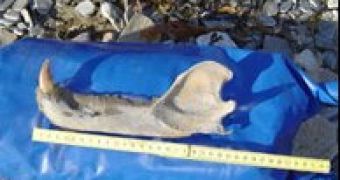Its future is bleak because of the global warming and ice melting, but its past is going to be revealed to us. A team led by Professor Olafur Ingolfsson, from the University of Iceland, has discovered what seems to be the oldest known fossil of a polar bear, on the Arctic Svalbard archipelago, on sediments 110,000 to 130,000 years old.
The jawbone could have belonged to an adult female and the biggest surprise is that the polar bears, the newest bear species, were believed to have been younger than 100,000 years ago.
"We have this specimen that confirms the polar bear was a morphologically distinct species at least 100,000 years ago, and this basically means that the polar bear has already survived one interglacial period. And what's interesting about that is that the Eeemian - the last interglacial - was much warmer than the Holocene (the present). This is telling us that despite the ongoing warming in the Arctic today, maybe we don't have to be quite so worried about the polar bear", said Ingolfsson.
The 23 cm (9 in) bone was discovered at Poolepynten on Prins Karls Forland, a narrow strip of land on the far west of the Svalbard.
"It is very well-preserved. We can measure various parameters, such as the cheek-teeth row-length, and the size of the hole made by the third molar - which is very characteristic of polar bears. We've compared all this, both to fossil and recent materials, and there's no question it's a polar bear", Ingolfsson told BBC News.
DNA comparisons between polar bears and brown bears, their closest relatives, showed that the two species had split from 70,000 years ago to as early as 1-1.5 million years ago.
But fossils cannot help much in this debate. Polar bears spend most of their lives on the ice, and their corpses are likely to be scavenged or fall to the bottom of the Arctic Ocean, that's why the new find is huge.
Many are concerned with the future of the superb beast in the conditions of the fast ice melting, as the animal depends on ice to hunt seals. The new fossil offers some hope.
"The polar bear is basically a brown bear that decided some time ago that it would be easier to feed on seals on the ice. So long as there are seals, there are going to be polar bears. I think the threat to the polar bears is much more to do with pollution, the build up of heavy metals in the Arctic", said Ingolfsson.
The team will attempt to get DNA from the fossil.

 14 DAY TRIAL //
14 DAY TRIAL //